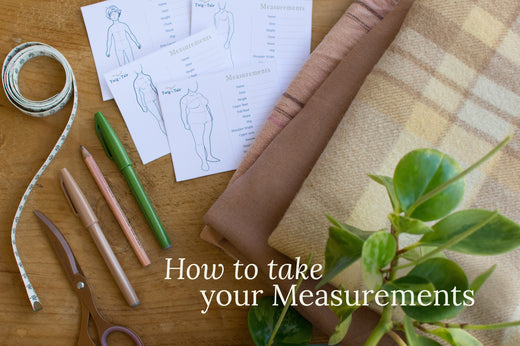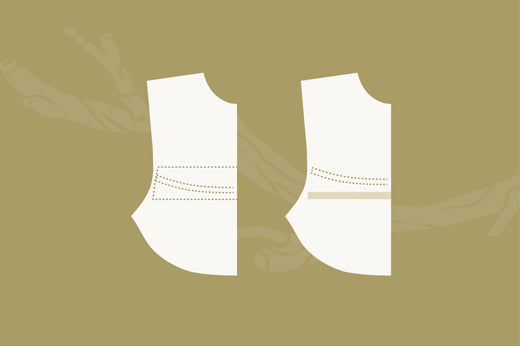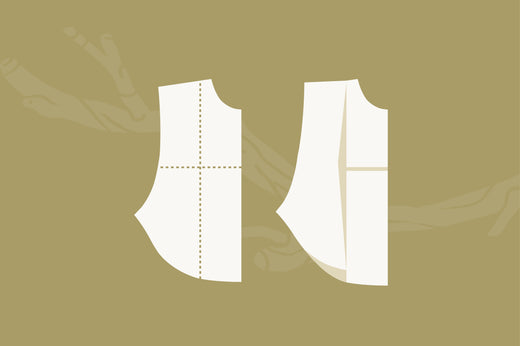Here are simple, step-by-step instructions for adjusting a raglan-style top with a dart to fit a smaller bust.
If you find that tops tend to sag over the bust, but fit well elsewhere, then this adjustment will help you to tailor the fit exactly where you need it. We also discuss changing the position of the dart based on your measurements. We're demonstrating the adjustment using the Grove Coat.
Making pattern adjustments may seem a bit daunting at first, but the effort is completely worth it to achieve a beautiful, handmade garment with a custom fit.

Materials
Gather some basic materials to adjust the pattern pieces:
- Top Front pattern piece (we're using the Grove Coat)
- measuring tape
- scrap paper
- tape
- ruler
- pen/pencil
- scissors
Measure
To determine the size of adjustment necessary, measure your upper bust and full bust.
The upper bust measurement is taken around the body, with the tape snugged up to the underarms, and above the breasts.
The full bust measurement is taken around the fullest part of the breasts.

If the difference between your upper bust measurement and your full bust measurement is less than 2", you may want to do a small bust adjustment.
Compare your body measurements to the size chart (click here to view, or it can be found in the pattern tutorial).
For example:
| Size H | Your body measurement | |
| Upper Bust measurement | 34" (86cm) | 34" (86cm) |
| Full Bust measurement | 36" (91cm) | 35" (96cm) |
Bust Apex
The bust apex is marked on the pattern. It is a good idea to measure your own bust apex to make sure the bust dart ends up in the correct position for your body.
To find your bust apex, measure from the curve where your shoulder meets your neck (imagine the position where a shoulder seam line would sit against your neck) to the centre of your bust - this is the part that points out the most. Note that the bust apex is not necessarily the same as your nipple position. We recommend taking this measurement while wearing your favourite underwear.

Check your measurement against the pattern.

Keep a note of the difference between your bust position versus the pattern. For example:
| Pattern | = 9.8" (25cm) |
| Your Bust Position | = 8.8" (22.5cm) |
| Difference | = 1" (2.5cm) |
Small Bust Adjustment
Adjust pattern pieces
1. Begin by drawing cut lines on the Front pattern piece as follows:
- Line parallel to Centre Front (CF) from the hem to the end of the dart (line a on diagram below).
- Line at right angles to CF from the dart end to CF line (line b on diagram).
- Line through centre of dart to dart point (line c on diagram).
- Line from dart end to stitch line of armhole seam (line d on diagram).

2. Cut the pattern along lines a-d, keeping the pivot points intact at the dart end and armhole seam allowance (see diagram for location of pivot points). If you accidentally snip through the pivot point, use some tape to create a hinge.

3. Be sure to mark the original dart end so you don't lose it in the changes. This is VERY important.

For the following steps, it is a good idea to position your pattern piece over a larger piece of paper, so that once the adjustments are made, you can cut around the entire finished piece. This will prevent the pieces from shifting around.
4. Secure the top section of the pattern piece with tape, then draw a line extending the CF edge below the pattern piece.

Now, apply your full bust difference to the pattern. In our example, the full bust difference is 1". Divide the difference in half: for example 1" (2.5cm) / 2 = 1/2" (1.25cm) because we are working on half of the front piece.
Slide the side section in by your calculated difference: our example is 1/2" (1.25cm). Let the dart and armhole pivot - the side will move inward so that the cut section overlaps and the dart begins to close up.

5. Slide the centre section up by 1/4" (6mm), along the CF line you drew earlier.

6. Redraw the dart stitching lines so that they meet at the point of the original dart end. Note that the dart end may slide underneath the pattern piece.
If the dart closes up completely, or becomes too small, you may eliminate the dart entirely.

7. Blend the hem and smooth the armhole if needed.

8. The adjustment is now complete; however, if your Bust Apex is different to the pattern, we'll continue below with a few more steps.

Modifying the Bust Apex
The dart should be positioned so that it points directly towards the Bust Apex. It may be necessary to move the dart up or down so that it is positioned correctly.
1. Cut two lines at right angles to the Centre Front Line, above and below the dart.

2. Slide the darted section up or down by the difference. In the example above, we calculated the difference as 1" (2.5cm) higher, so we will slide the piece up by that amount.

3. Blend the side seam on both sections.
Evenly space the buttonhole placements markers between the top and bottom buttons.

4. Your pattern piece is now ready to use!

If you are making a lined garment, you will also need to repeat the steps above for the lining and front facing.

Remember, we always recommend sewing a muslin to test out your pattern adjustment before cutting into your fancy fabric.
If you have any questions about sewing or adjusting Twig + Tale patterns, please feel free to join us at the Twig + Tale Facebook group.

Read more pattern adjustment tutorials here:
- Smaller Bust Adjustment (SBA) for a Top with a Bust Dart
- Shoulder Width Adjustment for a Raglan Sleeve
- Fuller Upper Arm Adjustment for a Raglan Sleeve with Shoulder Dart





